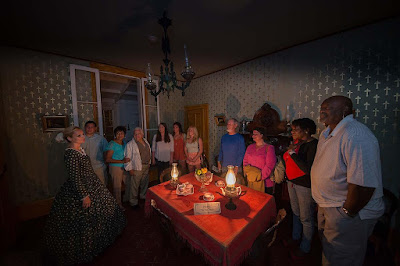 |
| An engraving of The Count of Saint Germain by Nicolas Thomas. |
The Count of Saint Germain was born into a royal, European family. Researchers are unsure of many facts and truths about the Count of Saint Germain due to his story being told so many times and his mysterious way of life. Researchers estimate the Count of Saint Germain was born around the late 1600’s or the early 1700’s and then went on to live for many years to follow. According to the article “Who was the Count of Saint Germain” written by Shelly Barclay, the Count of Saint Germain displayed many talents throughout his many years of life including composing musical pieces, playing the violin, speaking multiple languages, and combining many small diamonds to make one large diamond. One talent of his that was controversial was his ability to stop his own aging. In his article titled “Saint-Germain: The Immortal Count,” Stephen Wagner states that many accounts from the Count’s vast range of years of life always have him appearing to be around forty-five years old. Due to his ability to live for what seemed like forever, researchers refer to the Count of Saint Germain as “the man who never dies.”
While he was living his years of life, the Count traveled to many different countries to visit royal Europeans during his time. The Count’s many talents grabbed the attention of both commonfolk and royal figures. Some of the most famous Europeans the Count visited throughout his travels in Europe were King Louis XV and Giacomo Girolamo Casanova (Wagner). These royals not only enjoyed the Count being around for his talents, but they were also intrigued by his charming personality.
Due to the mysteriousness about the Count of Saint Germain and all the unknowns about his life, there are many different claims bystanders made about him. When it comes to his immortality, his ability to live forever, many bystanders claim that the Count of Saint Germain would “drink special tea frequently” and make comments about his age that seemed a little odd. He would reference things long before his time as if he was there, and he went around telling others that it was very possible for him to live more than one hundred years (Barclay). Some others claim that once the Count of Saint Germain did pass away, he came back from the dead and there were many more accounts of him. The Count was seen by others all the way up until the early 1970’s, still looking to be about forty-five years old, almost three hundred years old.
Who really was the Count of Saint Germain? Is he still around today? Will we ever know the complete truth about him and his life?
Barclay,
Shelly. “Who was the Count of Saint Germain?” June 25, 2010. Historic
Mysteries. https://www.historicmysteries.com/saint-germain/.
Thomas, Nicolas. “Count
of St Germain.” Wikimedia Commons, 1783, https://es.wikipedia.org/wiki/Conde_de_Saint_Germain#/media/Archivo:Count_of_St_Germain.jpg.
Accessed 20 Oct. 2022.
Wagner,
Stephen. “Saint-Germain: The Immortal Count.” December 29, 2018. Liveabout
dotcom. https://www.liveabout.com/saint-germain-the-immortal-count-2594421
Links for further research:
New Editions, The Music of the Count of St. Germain: An Edition, http://ichriss.ccarh.org/Germain.pdf. This entry on the Count of Saint Germain by Ilias Chrissochoidis emphasizes the Count’s admiration from other historical figures during his time due to his well-known musical compositions and performances.
The Count of Saint-Germain, http://davidpratt.info/st-germain1.htm. This entry on the Count of Saint Germain by David Pratt highlights the many events and acknowledgements of the Count of Saint Germain’s life due to his high praises from others, based on his many talents, possessions, accomplishments, or personality traits.
Count of St. Germain: The Man That Never Dies, https://owlcation.com/humanities/Count-of-St-Germain-That-Man-Never-Dies. This entry by Dean Traylor depicts the life of the Count of Saint Germain by explaining what both the commonfolk and royals of his time thought of him.



